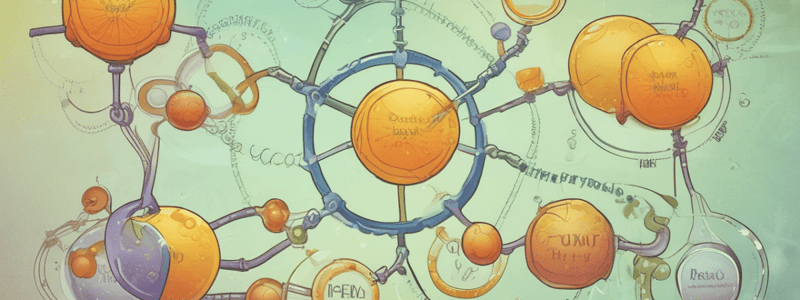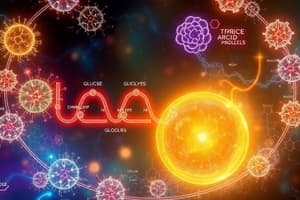Podcast
Questions and Answers
Which molecule is produced after the removal of 1 carbon from pyruvate in step 1?
Which molecule is produced after the removal of 1 carbon from pyruvate in step 1?
- Acetyl-CoA (correct)
- Lactate
- Oxaloacetate
- Fumarate
What is produced during the link reaction of the TCA cycle?
What is produced during the link reaction of the TCA cycle?
- NADPH
- NADH (correct)
- ATP
- FADH2
What is the process called where the position of atoms within a molecule is changed in step 2?
What is the process called where the position of atoms within a molecule is changed in step 2?
- Oxidation
- Phosphorylation
- Isomerisation (correct)
- Reduction
How many carbons does the pyruvate molecule contain before the link reaction?
How many carbons does the pyruvate molecule contain before the link reaction?
Which of the following is a correct description of the link reaction in the TCA cycle?
Which of the following is a correct description of the link reaction in the TCA cycle?
What energy-carrying molecule is produced in Step 5?
What energy-carrying molecule is produced in Step 5?
Which enzyme helps join GDP and phosphate group in Step 5?
Which enzyme helps join GDP and phosphate group in Step 5?
What process in Step 5 provides the energy needed for the reaction?
What process in Step 5 provides the energy needed for the reaction?
What type of molecule is produced along with FADH2 in Step 6?
What type of molecule is produced along with FADH2 in Step 6?
Which enzyme assists in changing the molecule back to its original 4 carbon form in Step 6?
Which enzyme assists in changing the molecule back to its original 4 carbon form in Step 6?
What happens to electrons in a redox reaction?
What happens to electrons in a redox reaction?
Which enzyme is involved in making or breaking double bonds between carbon atoms?
Which enzyme is involved in making or breaking double bonds between carbon atoms?
What molecule is reformed in step 8 during the citric acid cycle?
What molecule is reformed in step 8 during the citric acid cycle?
What is produced by transferring electrons to NAD+ during the citric acid cycle?
What is produced by transferring electrons to NAD+ during the citric acid cycle?
Which statement accurately describes the citric acid cycle?
Which statement accurately describes the citric acid cycle?
What is released when a three carbon molecule breaks down in the citric acid cycle?
What is released when a three carbon molecule breaks down in the citric acid cycle?
How many carbon atoms are left after a three carbon molecule breaks down?
How many carbon atoms are left after a three carbon molecule breaks down?
What does the two carbon molecule do after it is created?
What does the two carbon molecule do after it is created?
What happens when the two carbon molecule joins with a four carbon molecule?
What happens when the two carbon molecule joins with a four carbon molecule?
What happens to the six carbon molecule in the citric acid cycle?
What happens to the six carbon molecule in the citric acid cycle?
What happens to the 6 carbon molecule in Step 3?
What happens to the 6 carbon molecule in Step 3?
What is reduced to NADH in Step 3?
What is reduced to NADH in Step 3?
What is the role of oxidoreductase in Step 3?
What is the role of oxidoreductase in Step 3?
What changes occur to the 5 carbon molecule in Step 4?
What changes occur to the 5 carbon molecule in Step 4?
Which molecule captures electrons in Step 4?
Which molecule captures electrons in Step 4?
Flashcards are hidden until you start studying
Study Notes
Citric Acid Cycle (TCA Cycle)
Step 1: Link Reaction
- Links with glycolysis
- 3-carbon pyruvate molecule is converted into 2-carbon Acetyl-CoA
- 1 carbon is removed as CO2
- NADH is produced in the process
Step 2: Isomerization
- Atoms (hydrogen) within the molecule are rearranged
- Rearranged molecule is used in further reactions in the cycle
Step 3
- 1 carbon dioxide is removed, changing 6-carbon molecule to 5-carbon molecule
- Oxidoreductase enzymes assist in this process
- NAD+ is reduced to NADH, gaining electrons
- Energy is captured in the form of NADH
Step 4
- CO2 is removed, changing 5-carbon molecule to 4-carbon molecule
- NAD+ is reduced, producing more NADH by capturing electrons
- Oxidoreductase enzymes help in the process
Step 5
- Produces GTP (energy-carrying molecule)
- Phosphate group is added to GDP, converting it to ATP
- Breaking thioester bond provides energy for the reaction
- Ligase enzyme helps join GDP and phosphate group, making ATP
Step 6
- Molecule is changed back to the original 4-carbon molecule
- Oxidoreductase assists in this process
- Reaction produces NADH + FADH2, storing energy for later
- Completing the cycle to produce more energy
Step 7
- Electrons are transferred, changing the molecular structure
- Ligase enzyme helps make/break double bonds between carbon atoms
Step 8
- 4-carbon molecule oxaloacetate is reformed
- Redox reaction occurs, producing more NADH by transferring electrons to NAD+
Redox Reactions
- Oxidation = loss of electrons
- Reduction = gain of electrons
Studying That Suits You
Use AI to generate personalized quizzes and flashcards to suit your learning preferences.



